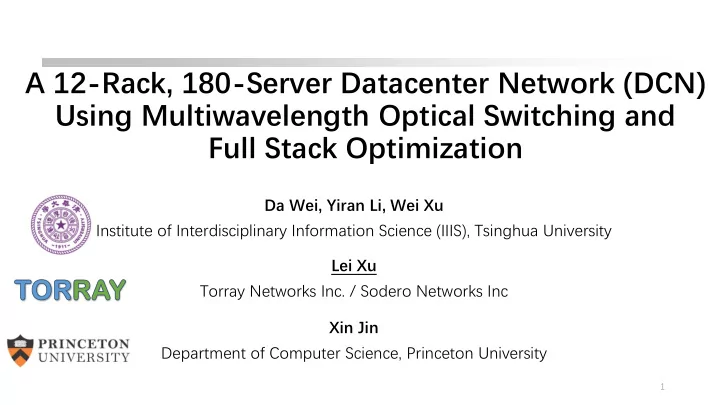

A 12-Rack, 180-Server Datacenter Network (DCN) Using Multiwavelength Optical Switching and Full Stack Optimization Da Wei, Yiran Li, Wei Xu Institute of Interdisciplinary Information Science (IIIS), Tsinghua University Lei Xu Torray Networks Inc. / Sodero Networks Inc Xin Jin Department of Computer Science, Princeton University 1
Hy Hyper er Conv nverged erged Clo loud ud => => More re So Sophist histic icated ated DC DCNs Ns • Hyper converged infrastructure • Different applications running over thousands of servers Virtualization Layer • Workloads change fast Network • Mix of short and long flows • Diverse requirements of different applications • Search - Latency • Hadoop – Throughput Compute Pool Storage Pool • … Hyper converged infrastructure • We need a FLEXIBLE network to cope with the challenges 2
Pre revious vious Wo Work rk on on Op Optical tical DC DCN Early demonstrations of optically switched DCN testbed • K. Chen, A. Singla , A. Singh, L. Xu, Y. Zhang, “ OSA : An Optical Switching Architecture for Data Center Networks with Unprecedented Flexibility”, Proc. of USENIX NSDI conference, April 2012. • G. Wang, D. G. Andersen, M. Kaminsky, M. Kozuch, T. S. E. Ng, K. Papagiannaki, and M. Ryan, “ c-Through : Part-time Optics in Data Centers'', Proc. ACM SIGCOMM, Aug. 2010. • N. Farrington, G. Porter, S. Radhakrishnan, H. Bazzaz, V. Subramanya, Y. Fainman, G. Papen, and A. Vahdat , “ Helios: A Hybrid Electrical/Optical Switch Architecture for Modular Data Centers”, Proc. of ACM SIGCOMM, August 2010 Ever since, optical switching for intra- and inter- DCN applications has attracted strong interests in both academia and industry. 3
Lo Long ng Tai ail l La Late tency ncy Is Issue sues in s in DC DCN • Tail latency directly impacts the quality of service • Long tail latency caused by congestions from • Traffic bursts • Uneven load balancing Two orders of magnitude variations in RTT D. Zats, T. Das, P. Mohan, D. Borthakur , and R. Katz, “ DeTail : reducing the flow completion time tail in datacenter networks”, Proc. of ACM SIGCOMM, August 2012 4
DFabric DCN • 12 racks, 180 servers • WSS-based multiwavelength switching and interconnection (without central optical switching matrix) • Hyper-cube topology • OpenFlow enabled top-of-rack switches (ToR) • Full stack controller and optimization Full Stack Controller Optical Manager OSUs ToRs 5
Op Optical tical Swi witching tching Un Unit it (OS OSU) ) De Design sign Full Stack Controller Optical Manager OSUs ToRs Built from off-the-shelf components 6
Full Stack Controller Tr Traffic ffic Mo Moni nitoring ing and nd Vi Visual sualiz izatio ation Optical Manager OSUs Controlled by the optical manager: ToRs Aggregated real-time network traffic Real-time per-link utilization 7
8
Full Stack Controller Ful ull-stack stack op optimiza timization tion Optical Manager OSUs • Balance load on links to avoid congestion ToRs Optimization goal: minimize the maximum single link utilization • Joint optimization of the optical and network layers The problem is NP-hard Randomized approximation algorithm based on simulated annealing Randomly alter ONE optical link Network Current New Topology Topology Topology Several iterations Accept if new topology is better 9
Full Stack Controller Key Alg Key lgorithm orithm Id Ideas eas Optical Manager OSUs • Reduce search space using network-layer topology as the state ToRs • Starting with topology that is similar to the current one Randomly alter ONE optical link Network Current New Topology Topology Topology Several iterations Accept if new topology is better 10
Full Stack Controller Consistent Update Optical Manager OSUs • Problem: ensure no packet loss during update process ToRs • Extend the state-of-the-art network update solution Dionysus [3] • Dionysus uses dependency graph to schedule update operations • The dependency graph includes two types of nodes: • fNode - Update operation that moves a flow from an old path to a new path • λNode – Update operation that moves a wavelength from an old edge to a new edge λ 1 f 1 λ 2 f 2 λ 3 Example of dependency graph [3] X. Jin, H. Liu, R. Gandhi, S. Kandula, R. Mahajan, M. Zhang, J. Rexford, R. Wattenhofer , “Dynamic scheduling of network updates." Proc. of ACM SIGCOMM, Aug 2014 11
Resu esult lts: : Lo Long ng Tail ail La Late tency ncy Red eduction uction • Optimized topology vs. static topology • Subset of 8 racks with three traffic patterns • Pattern 1: Cross-network bulk data transfer • Pattern 2: Two separate traffic intensive cliques, with limited traffic in between. • Pattern 3: All-to-all uniformly distributed traffic 99th percentile of round trip time 12
Results: Effective Consistent Update • One shot update: move all affected flows onto a default link • Congestion causes significant packet drop • No significant change in consistent update Consistent update vs. one shot update 13
Conclusion • We present DFabric: a 12-rack, 180-server DCN using multiwavelength switching and interconnection. • We implemented real-time network traffic and per-link utilization monitoring, full-stack optimization by jointly optimizing optical switching and network flow routing, and network status consistent update. • We show benefits in long tail latency reduction and packet loss drop. 14
Recommend
More recommend